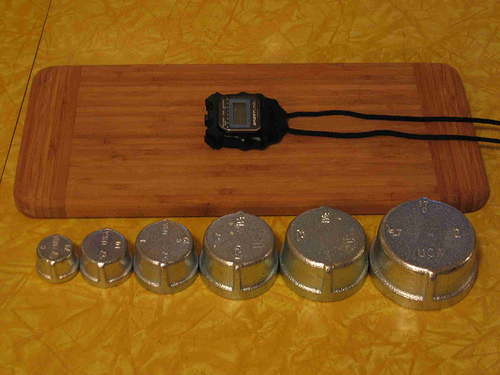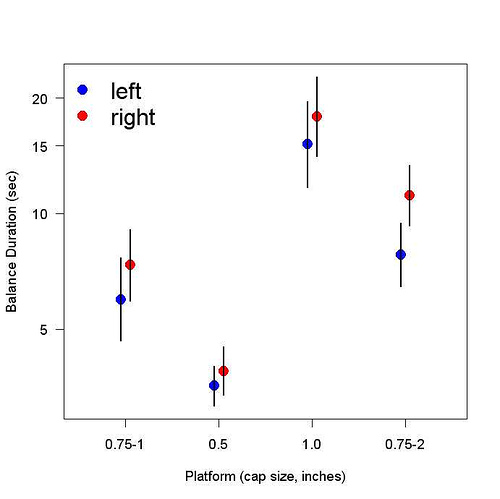Why is now a great time to be alive? Because Philip Weiss, one of my favorite writers, has a blog. Today’s entry mentioned a story about teaching the Torah while standing on one foot.
Speaking of standing on one foot . . . I devised a way to measure my balance. (To recap: I want to measure my balance to see if omega-3 improves it. When I increased my omega-3 consumption via walnut oil and flaxseed oil, it suddenly became much easier to put on my shoes while standing, which I’d been doing for years. The omega-3 also improved my sleep. Maybe omega-3 makes much of the human brain work better, especially the most-recently-evolved portions. Maybe this effect happens within hours.)
Here is the method. Equipment. At a hardware store I bought a series of 6 pipe caps, caps for 0.5 inch pipe, 0.75 inch pipe, 1.0 inch pipe, 1.25 inch pipe, 1.5 inch pipe, and 2.0 inch pipe (total $24). At a new-age pharmacy I bought a thick foot-sized cutting board (made of bamboo, $15). Below is a picture of these items and my stopwatch, which measures times to 0.01 second. Procedure. I put the board on one of the caps and balance on the board on one foot. I measure with a stopwatch how long I can balance on it before putting the other foot down. After 30 seconds, the trial stops — 30 seconds is the maximum possible score. I stand on my left foot for several trials (e.g., 12), then switch to my right foot for several trials.

The reason for six different caps — six different platforms — is to be able to adjust the difficulty so that it is neither too easy nor too hard — if either were the case the measurements wouldn’t be telling me much. With a little trial and error, the 0.75-inch cap seemed to be best. Below is data from that cap and the smaller and larger caps. With each foot I balanced 12 times; the graph shows the means and standard errors on a log scale. The sequence of conditions was: (1) 0.75-inch cap, (2) 0.5-inch cap, (3) 1.0-inch cap, (4) 0.75-inch cap. I balanced on each foot 12 times in each of the 4 conditions.
The results make sense: the smaller the platform, the less time I could balance on it. There appears to be a practice effect — better scores with more practice. I hope with more experience this effect will go away. The next step is to do these measurements several times per day for several days so that I can get some idea of how much they vary “naturally” — what the background variation is.
Hi – I love your book – terrific.
Quick report: I’ve been sleeping radically better since starting to take Omegabrites at bedtime. I’d stopped taking them because they were making me nauseous, and I hadn’t associated the decline in sleep with lack of Omega 3s.
Am now on a quest to locate Spectrum Walnut oil.